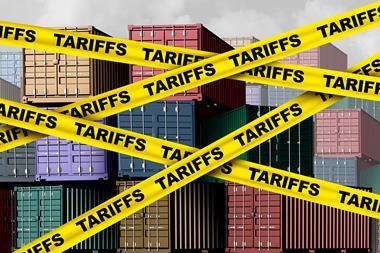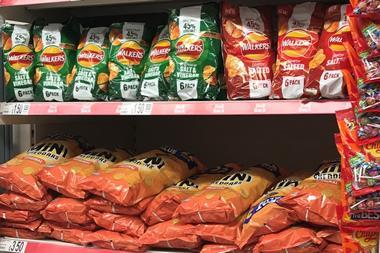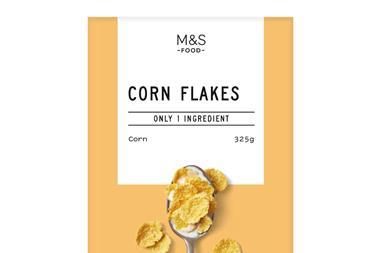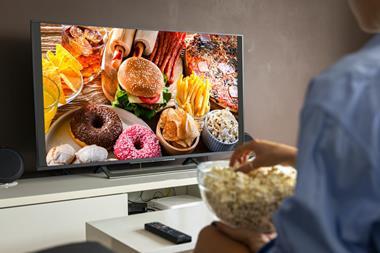Six schoolchildren are sitting in a circle playing cards. It appears to be an ordinary playground game of Top Trumps, but a closer look shows they are not comparing stats on tanks, aircrafts, or dinosaurs. Not even popular film celebrities. It's food.
"Marmite, 19.2g of total carbohydrates - high," says one. "I've got marmalade, with 62.3g," says another, taking his card off him. "I win."
This is Woodleigh School, in the small town of Langton, Yorkshire, and the children are playing a card game devised with the help of headmaster Michael England.
The premise is simple. Each card in the pack contains standard nutritional information (energy, protein, carbohydrates, fat, fibre and salt) on each of 52 products. The cards also indicate how each product scores based on traffic-light labelling and Guideline Daily Amounts. And the school has devised a further gold, silver or bronze ranking which brings portion sizes into the equation (see box, p41). To win, the player picks a nutrient value they think is the most impressive for that particular product. The other players then attempt to trump it with one of their own product cards.
It all started when England, who teaches personal, social and health classes to 10 to 13-year-olds, was trying to think of ways to engage his pupils on the growing perils of obesity. "I asked children to cut out the nutritional information details of well-known food products and stick them on to a big piece of cardboard so they could get a closer understanding of what's in the products they are eating," he says. "But the children said this didn't look very nice and asked if we could make lots of cards. They then started to compare each other's products. So the logical step was to turn it into a game."
Children use the info-packed cards to play no fewer than five different games (see p43), but all have one overriding aim: to teach children about food and nutrition labelling in a way that's more fun and informative than traditional classroom methods.
As Britain struggles to come to terms with a growing childhood obesity problem, the game couldn't be more different from traditional lessons used to teach nutrition to kids in schools.
The Wheel of Health, launched in 1994, breaks food down into five groups - fruit and vegetables; bread, cereals and potatoes; milk and dairy; meat and fish; and fat and sugar - but it bears no obvious relation either to the products that children regularly consume, or to the controversial labelling schemes that have been devised by the Food Standards Agency, with its traffic-light system, and the industry with its Guideline Daily Amounts.
And, of course, it couldn't be more different from the further example, set by the FSA with the notorious Nutrient Profiling Model, developed for media regulator Ofcom to classify so-called junk foods, but which has led to a TV advertising ban, to children, of a number of healthy and nutritious products - including honey, Marmite, raisins, cheese, olive oil, Bran Flakes, low-fat spreads, leading The Grocer to launch its Weigh It Up! campaign earlier this year.
If it sounds complicated, says England, it's like any game: it gets easier once you learn the rules and have a few practice runs. And because it is a game rather than a lesson, he adds, children are much more disposed to persevere with it.
It's certainly having some remarkable effects. "I used to eat more sweets than I do now," says Charlotte, 11. "The game makes you understand that you should only eat a little bit." "It makes you much more aware of what you should be eating, and how much," adds Clayton, 13.
England is delighted. "For the first time children are really looking at labels. I've created a school full of complete nutrition nerds."
Carole Lewis, a nutrition consultant who has been advising Woodleigh School in the development of the game, thinks it is "an absolutely brilliant idea" because it is fun. "Nutrition and nutritional labelling is such a dry and difficult subject to teach," she says. "Normally children are taught using only facts and figures. In some instances teachers may not even try. But children love Top Trumps and since children get a lot more out of education when they are having fun, they are learning by default."
As well as games that children play using the cards, they are also used in classes. Children are assigned to create a virtual sandwich using information on a bread card and two additional ingredients. The children have to calculate the various nutritional values of the sandwich, such as how much protein, fibre, salt and carbohydrates it provides, and work out what contribution it makes to their GDAs.
"Traditional teaching of food doesn't give children a fun way of manipulating the figures," says England, "but this does.
"They have to dissect their lunch and add up each key nutrient to see how healthy it is and then put it into context of a daily diet. Even biology teachers and mathematicians love it because they say it gives kids a reason to talk about percentages."
As the game was being developed the children had initially thought to base it on the FSA's traffic-light labelling scheme, but realised that the 100g measure it used created some "serious anomalies". "Traffic lights make some things seem good until you think how much you eat while others seem bad until you realise how little you eat," says Clayton.
England adds: "The children found traffic lights work with some products but quickly found some serious anomalies on products such as Marmite and mustard. However, we decided to keep traffic lights on the cards to demonstrate to children the instances when they don't really work."
The GDA system was, therefore, included because it was considered a more accurate system for determining HFSS foods, but still the development team wasn't satisfied. As Georgina, 11, explains: "GDAs are complicated. They tell me more if I can be bothered to think about it. But the problem is, when you're shopping, you don't want to do a maths lesson."
The answer was to introduce an additional gold, silver and bronze colour coding system. This removes the negative connotations of a red light, but, more importantly, considers portion sizes in true context. "While many products carry GDAs, they don't make the distinction between maximum limits, minimum limits and average limits," England explains. "People interpret GDAs as a guideline daily limit, but in some cases it is also a target. We teach children that gold, for a particular category, means you can eat it in unlimited quantities. If it's silver, they know they can exceed the GDA but need to think about it more. And if it's in the bronze band, it must be consumed within the limits."
So, for instance, salt is classified as bronze because its GDA of 6g is a maximum target; protein is always silver to tell children they can consume more than the GDA but need to 'stay within limits'; and fibre is gold to demonstrate the GDA can safely be exceeded.
England adds: "Children are becoming more health-aware and they understand what makes up a healthy diet but they don't always know about the quantities of certain foods they should be eating. This is where the card game comes in. It makes them look at the serving size, which is fundamentally what GDA is about, but also understand how much they should be eating for a healthy and balanced diet. A child becomes aware of what is a high score for something like protein or salt, and will remember it."
With the card game now a proven success at his school, England believes he can get schoolchildren working with the food and drink industry to address the problem, for the first time, at grass roots level, and now plans to roll out the idea on a national level, selling it into other schools in batches of 10 at £3 a pack. He's already set up a separate business called Ed Stats (short for Educational Statistics) and given a 0.25% stake to 17 children at the school. England himself will own an 85% stake. The company is set to go live with a website that will offer a trial of the game to prospective buyers.
But there are one or two hurdles still to overcome. First, he needs money. The company has won a £5,000 cash injection from business angels after taking part in a 'Lion's Lair' event with neighbouring schools competing for money from local businessmen. One of the angels is Michael Oughtred, a former Woodleigh pupil and vice chairman of William Jackson, the Yorkshire-based owner of Jacksons Bakeries, Tryton Foods, Parripak, Kwoks and Hazeldene Foods. England is in talks with Morrisons to sponsor the back of the cards in return for funding to produce the first 10,000 packs.
Above all, though, Ed Stats needs permission to feature a proper range of well-known branded products on the cards. Kettle Chips has agreed to the use of its ready salted crisps on one of the cards and Tryton Foods has signed up via its Aunt Bessie's brand. In total, he has been in discussion with 32 companies to date, including PepsiCo, UBUK, Innocent, Masterfoods and Duchy Originals, and believes products from Premier Foods, Ryvita, Masterfoods, Kellogg's and Birds Eye are close to approval. Only Heinz, Nestlé and Cadbury have so far given an outright no, he adds.
England admits there are negative perceptions to overcome. One objection among manufacturers is the use of traffic-light labelling. Because traffic lights are based on a 100g serving they stigmatise products normally consumed in far smaller portions. However, the cards incorporate the labelling system precisely to demonstrate its shortcomings, says England.
A bigger hurdle is the fact it needs products considered unhealthy for children, such as confectionery and carbonated drinks, to make the game work. It is the manufacturers of these products that will be the hardest ones to convince, England concedes.
"It won't be a problem getting healthy products to sign up, but we need to persuade companies that make products that aren't considered healthy as well. The only way the game will work is if children can compare lots of different types of products and understand those that are high in fat, salt and sugar, and those that aren't."
England remains confident nonetheless. The underlying message of the game is to teach children about a balanced diet, and he believes this will encourage more companies like Kettle Chips to sign up and demonstrate their commitment to helping cut childhood obesity.
"When I wrote to Kettle initially, it said it only promoted its products to adults and wouldn't be relevant to our game. But I wrote back and said 'You've missed the point. We want your involvement. You are a sensitive product because crisps are not seen as healthy.' But as I told them, it will help us enormously to have some things that on the face of it are not healthy. What swung it for us was the message that will come out of the game: that all foods are fine in moderation."
The kids are convinced, too, and believe companies have a lot to gain. As Tom says: "If a company makes a product that might not look healthy but is prepared to put it on our cards to educate people about nutrition, it shows they are serious about their corporate social responsibility." And you thought kids were treating this as a game.
For more information on the game contact Michael England on 01653 658215 or email dme@woodleighschool.com
"Marmite, 19.2g of total carbohydrates - high," says one. "I've got marmalade, with 62.3g," says another, taking his card off him. "I win."
This is Woodleigh School, in the small town of Langton, Yorkshire, and the children are playing a card game devised with the help of headmaster Michael England.
The premise is simple. Each card in the pack contains standard nutritional information (energy, protein, carbohydrates, fat, fibre and salt) on each of 52 products. The cards also indicate how each product scores based on traffic-light labelling and Guideline Daily Amounts. And the school has devised a further gold, silver or bronze ranking which brings portion sizes into the equation (see box, p41). To win, the player picks a nutrient value they think is the most impressive for that particular product. The other players then attempt to trump it with one of their own product cards.
It all started when England, who teaches personal, social and health classes to 10 to 13-year-olds, was trying to think of ways to engage his pupils on the growing perils of obesity. "I asked children to cut out the nutritional information details of well-known food products and stick them on to a big piece of cardboard so they could get a closer understanding of what's in the products they are eating," he says. "But the children said this didn't look very nice and asked if we could make lots of cards. They then started to compare each other's products. So the logical step was to turn it into a game."
Children use the info-packed cards to play no fewer than five different games (see p43), but all have one overriding aim: to teach children about food and nutrition labelling in a way that's more fun and informative than traditional classroom methods.
As Britain struggles to come to terms with a growing childhood obesity problem, the game couldn't be more different from traditional lessons used to teach nutrition to kids in schools.
The Wheel of Health, launched in 1994, breaks food down into five groups - fruit and vegetables; bread, cereals and potatoes; milk and dairy; meat and fish; and fat and sugar - but it bears no obvious relation either to the products that children regularly consume, or to the controversial labelling schemes that have been devised by the Food Standards Agency, with its traffic-light system, and the industry with its Guideline Daily Amounts.
And, of course, it couldn't be more different from the further example, set by the FSA with the notorious Nutrient Profiling Model, developed for media regulator Ofcom to classify so-called junk foods, but which has led to a TV advertising ban, to children, of a number of healthy and nutritious products - including honey, Marmite, raisins, cheese, olive oil, Bran Flakes, low-fat spreads, leading The Grocer to launch its Weigh It Up! campaign earlier this year.
If it sounds complicated, says England, it's like any game: it gets easier once you learn the rules and have a few practice runs. And because it is a game rather than a lesson, he adds, children are much more disposed to persevere with it.
It's certainly having some remarkable effects. "I used to eat more sweets than I do now," says Charlotte, 11. "The game makes you understand that you should only eat a little bit." "It makes you much more aware of what you should be eating, and how much," adds Clayton, 13.
England is delighted. "For the first time children are really looking at labels. I've created a school full of complete nutrition nerds."
Carole Lewis, a nutrition consultant who has been advising Woodleigh School in the development of the game, thinks it is "an absolutely brilliant idea" because it is fun. "Nutrition and nutritional labelling is such a dry and difficult subject to teach," she says. "Normally children are taught using only facts and figures. In some instances teachers may not even try. But children love Top Trumps and since children get a lot more out of education when they are having fun, they are learning by default."
As well as games that children play using the cards, they are also used in classes. Children are assigned to create a virtual sandwich using information on a bread card and two additional ingredients. The children have to calculate the various nutritional values of the sandwich, such as how much protein, fibre, salt and carbohydrates it provides, and work out what contribution it makes to their GDAs.
"Traditional teaching of food doesn't give children a fun way of manipulating the figures," says England, "but this does.
"They have to dissect their lunch and add up each key nutrient to see how healthy it is and then put it into context of a daily diet. Even biology teachers and mathematicians love it because they say it gives kids a reason to talk about percentages."
As the game was being developed the children had initially thought to base it on the FSA's traffic-light labelling scheme, but realised that the 100g measure it used created some "serious anomalies". "Traffic lights make some things seem good until you think how much you eat while others seem bad until you realise how little you eat," says Clayton.
England adds: "The children found traffic lights work with some products but quickly found some serious anomalies on products such as Marmite and mustard. However, we decided to keep traffic lights on the cards to demonstrate to children the instances when they don't really work."
The GDA system was, therefore, included because it was considered a more accurate system for determining HFSS foods, but still the development team wasn't satisfied. As Georgina, 11, explains: "GDAs are complicated. They tell me more if I can be bothered to think about it. But the problem is, when you're shopping, you don't want to do a maths lesson."
The answer was to introduce an additional gold, silver and bronze colour coding system. This removes the negative connotations of a red light, but, more importantly, considers portion sizes in true context. "While many products carry GDAs, they don't make the distinction between maximum limits, minimum limits and average limits," England explains. "People interpret GDAs as a guideline daily limit, but in some cases it is also a target. We teach children that gold, for a particular category, means you can eat it in unlimited quantities. If it's silver, they know they can exceed the GDA but need to think about it more. And if it's in the bronze band, it must be consumed within the limits."
So, for instance, salt is classified as bronze because its GDA of 6g is a maximum target; protein is always silver to tell children they can consume more than the GDA but need to 'stay within limits'; and fibre is gold to demonstrate the GDA can safely be exceeded.
England adds: "Children are becoming more health-aware and they understand what makes up a healthy diet but they don't always know about the quantities of certain foods they should be eating. This is where the card game comes in. It makes them look at the serving size, which is fundamentally what GDA is about, but also understand how much they should be eating for a healthy and balanced diet. A child becomes aware of what is a high score for something like protein or salt, and will remember it."
With the card game now a proven success at his school, England believes he can get schoolchildren working with the food and drink industry to address the problem, for the first time, at grass roots level, and now plans to roll out the idea on a national level, selling it into other schools in batches of 10 at £3 a pack. He's already set up a separate business called Ed Stats (short for Educational Statistics) and given a 0.25% stake to 17 children at the school. England himself will own an 85% stake. The company is set to go live with a website that will offer a trial of the game to prospective buyers.
But there are one or two hurdles still to overcome. First, he needs money. The company has won a £5,000 cash injection from business angels after taking part in a 'Lion's Lair' event with neighbouring schools competing for money from local businessmen. One of the angels is Michael Oughtred, a former Woodleigh pupil and vice chairman of William Jackson, the Yorkshire-based owner of Jacksons Bakeries, Tryton Foods, Parripak, Kwoks and Hazeldene Foods. England is in talks with Morrisons to sponsor the back of the cards in return for funding to produce the first 10,000 packs.
Above all, though, Ed Stats needs permission to feature a proper range of well-known branded products on the cards. Kettle Chips has agreed to the use of its ready salted crisps on one of the cards and Tryton Foods has signed up via its Aunt Bessie's brand. In total, he has been in discussion with 32 companies to date, including PepsiCo, UBUK, Innocent, Masterfoods and Duchy Originals, and believes products from Premier Foods, Ryvita, Masterfoods, Kellogg's and Birds Eye are close to approval. Only Heinz, Nestlé and Cadbury have so far given an outright no, he adds.
England admits there are negative perceptions to overcome. One objection among manufacturers is the use of traffic-light labelling. Because traffic lights are based on a 100g serving they stigmatise products normally consumed in far smaller portions. However, the cards incorporate the labelling system precisely to demonstrate its shortcomings, says England.
A bigger hurdle is the fact it needs products considered unhealthy for children, such as confectionery and carbonated drinks, to make the game work. It is the manufacturers of these products that will be the hardest ones to convince, England concedes.
"It won't be a problem getting healthy products to sign up, but we need to persuade companies that make products that aren't considered healthy as well. The only way the game will work is if children can compare lots of different types of products and understand those that are high in fat, salt and sugar, and those that aren't."
England remains confident nonetheless. The underlying message of the game is to teach children about a balanced diet, and he believes this will encourage more companies like Kettle Chips to sign up and demonstrate their commitment to helping cut childhood obesity.
"When I wrote to Kettle initially, it said it only promoted its products to adults and wouldn't be relevant to our game. But I wrote back and said 'You've missed the point. We want your involvement. You are a sensitive product because crisps are not seen as healthy.' But as I told them, it will help us enormously to have some things that on the face of it are not healthy. What swung it for us was the message that will come out of the game: that all foods are fine in moderation."
The kids are convinced, too, and believe companies have a lot to gain. As Tom says: "If a company makes a product that might not look healthy but is prepared to put it on our cards to educate people about nutrition, it shows they are serious about their corporate social responsibility." And you thought kids were treating this as a game.
For more information on the game contact Michael England on 01653 658215 or email dme@woodleighschool.com



















No comments yet